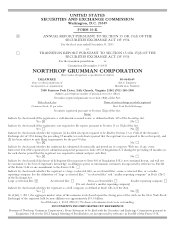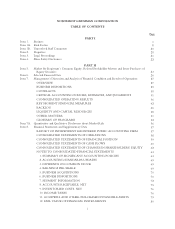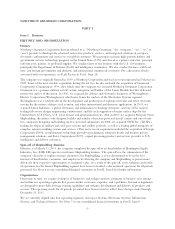Northrop Grumman 2011 Annual Report Download - page 16
Download and view the complete annual report
Please find page 16 of the 2011 Northrop Grumman annual report below. You can navigate through the pages in the report by either clicking on the pages listed below, or by using the keyword search tool below to find specific information within the annual report.NORTHROP GRUMMAN CORPORATION
backlog. For multi-year services contracts with non-federal government customers having no stated contract
values, backlog includes only the amounts committed by the customer. Backlog is converted into sales as work is
performed or deliveries are made. At December 31, 2011, total backlog was $39.5 billion, compared with $46.8
billion at the end of 2010, and includes a $3 billion adjustment for a change in the company’s backlog
measurement criteria, which acknowledges, in our judgment, the reduced likelihood of amounts remaining on
certain open, but unfulfilled contracts, being realized as future sales. Approximately 59 percent of backlog at
December 31, 2011, is expected to be converted into sales in 2012. For backlog by segment, see Backlog in Part
II, Item 7.
RAW MATERIALS
While we have generally been able to obtain key raw materials required in our production processes in a timely
manner, a significant delay in supply deliveries could have a material adverse effect on the company’s consolidated
financial position, results of operations, or cash flows. See Risk Factors in Part I, Item 1A and Overview –
Outlook in Part II, Item 7.
GOVERNMENT CONTRACT REGULATION
Our businesses are affected by numerous laws and regulations, including those relating to the award, administration
and performance of U.S. Government contracts. See Risk Factors in Part I, Item 1A.
The U.S. Government generally has the ability to terminate our contracts, in whole or in part, without prior
notice, for convenience or for default based on performance. If a U.S. Government contract were to be
terminated for convenience, we would generally be protected by provisions covering reimbursement for costs
incurred on the contracts and profit on those costs, but not the anticipated profit that would have been earned had
the contract been completed. In the unusual circumstance where a U.S. Government contract does not have such
termination protection, we attempt to mitigate the termination risk through other means. Termination resulting
from our default may expose us to liability and could have a material adverse effect on our ability to compete for
other contracts. See Risk Factors in Part I, Item 1A.
Certain programs with the U.S. Government that are prohibited by the customer from being publicly discussed in
detail are referred to as “restricted” in this Form 10-K. The consolidated financial statements and financial
information in this Form 10-K reflect the operating results of restricted programs under accounting principles
generally accepted in the United States of America (GAAP).
RESEARCH AND DEVELOPMENT
Our research and development activities primarily include independent research and development (IR&D) efforts
related to government programs. IR&D expenses are included in general and administrative expenses and are
generally allocated to U.S. Government contracts. Company-sponsored IR&D expenses totaled $543 million,
$580 million, and $588 million in 2011, 2010, and 2009, respectively. Expenses for research and development
sponsored by the customer are charged directly to the related contracts.
EMPLOYEE RELATIONS
We believe that we maintain good relations with our 72,500 employees, of which approximately 3,400 are
covered by 17 collective bargaining agreements. We negotiated or re-negotiated three of our collective bargaining
agreements in 2011 and expect to re-negotiate renewals for nine of our collective bargaining agreements in 2012.
These negotiations had no material adverse effect on our results of operations. For risks associated with collective
bargaining agreements, see Risk Factors in Part I, Item 1A.
ENVIRONMENTAL MATTERS
Our manufacturing operations are subject to and affected by federal, state, foreign, and local laws and regulations
relating to the protection of the environment. The estimated cost to complete remediation is accrued when it is
probable that the company will incur costs to address environmental impacts at currently or formerly owned or
leased operating facilities or at sites where the company has been named a Potentially Responsible Party (PRP) by
-6-
























